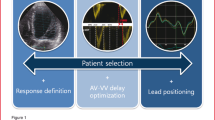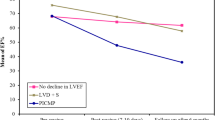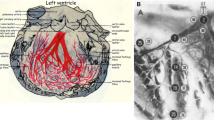Abstract
Echocardiography shows that multiphasic septal movement and a septal to lateral apical systolic left ventricular (LV) motion have a high predictive value for dyssynchrony and the response to cardiac resynchronisation therapy (CRT). Presence of dyssynchrony is also the major marker for CRT response in the presence of scar tissue, provided the interventricular (V-V) pacing interval is optimalised. For atrioventricular (AV) interval optimisation, the velocity-time integral of the transmitral flow has an excellent correlation with invasive LVdP/dtmax. In acute haemodynamic measurements, LVdP/dtmax shows strongly the effect of AV and V-V optimisation. It also illustrates that the haemodynamic effect of LV pacing when associated with intrinsic conduction over the right bundle is equal to or better than biventricular pacing. We found that once AV and V-V interval were optimised, QRS morphology could be used as a template for optimal therapy. Automated continuous optimisation of the pacing intervals will be the big challenge for the future. (Neth Heart J 2008;16(suppl 1):S32-S35).
Similar content being viewed by others
References
Bristow MR, Saxon LA, Boehmer J, Krueger S, Kass DA, De Marco T, et al. Cardiac-resynchronization therapy with or without an implantable defibrillator in advanced chronic heart failure. N Engl J Med 2004;350:2140-50.
Cleland JG, Daubert JC, Erdmann E, Freemantle N, Gras D, Kappenberger L, et al. The effect of cardiac resynchronization on morbidity and mortality in heart failure. N Engl J Med 2005;352:1539-49.
Bleeker GB, Kaandorp TA, Lamb HJ, Boersma E, Steendijk P, de Roos A, et al. Effect of posterolateral scar tissue on clinical and echocardiographic improvement after cardiac resynchronization therapy. Circulation 2006;113:969-76.
Jansen AH, Bracke FA, van Dantzig JM, Meijer A, van der Voort PH, Aarnoudse W, et al. Correlation of echo-Doppler optimization of atrioventricular delay in cardiac resynchronization therapy with invasive hemodynamics in patients with heart failure secondary to ischemic or idiopathic dilated cardiomyopathy. Am J Cardiol 2006;97:552-7.
Van Gelder BM, Bracke FA, Meijer A, Lakerveld LJ, Pijls NH. Effect of optimizing the W interval on left ventricular contractility in cardiac resynchronization therapy. Am J Cardiol 2004;93:1500-3.
Anderson LJ, Miyazaki C, Sutherland GR, Oh JK. Patient selection and echocardiographic assessment of dyssynchrony in cardiac resynchronization therapy. Circulation 2008;117:2009-23.
Jansen AH, Bracke F, van Dantzig JM, Meijer A, Korsten EH, Peels KH, et al. Optimization of pulsed wave tissue Doppler to predict left ventricular reverse remodeling after cardiac resynchronization therapy. J Am Soc Echocardiogr 2006;19:185-91.
Yu CM, Gorcsan J, III, Bleeker GB, Zhang Q, Schalij MJ, Suffo-letto MS, et al. Usefulness of tissue Doppler velocity and strain dyssynchrony for predicting left ventricular reverse remodeling response after cardiac resynchronization therapy. Am J Cardiol 2007;100:1263-70.
Yu CM, Abraham WT, Bax J, Chung E, Fedewa M, Ghio S, et al. Predictors of response to cardiac resynchronization therapy (PROSPECT)–study design. Am Heart J 2005;149:600-5.
Jansen AH, van Dantzig JM, Bracke F, Meijer A, Peels KH, van den Brink RB, et al. Qualitative observation of left ventricular multiphasic septal motion and septal-to-lateral apical shuffle predicts left ventricular reverse remodeling after cardiac resynchronization therapy. Am J Cardiol 2007;99:966-9.
Ansalone G, Giannantoni P, Ricci R, Trambaiolo P, Fedele F, Santini M. Doppler myocardial imaging to evaluate the effectiveness of pacing sites in patients receiving biventricular pacing. J Am Coll Cardiol 2002;39:489-99.
Jansen AH, Bracke F, Dantzig JM, Peels KH, Post JC, van den Bosch HC, et al. The influence of myocardial scar and dyssynchrony on reverse remodeling in cardiac resynchronization therapy. Eur J Echocardiogr 2008;9:483-8.
Van Gelder BM, Meijer A, Bracke FA. Stimulation rate and optimal interventricular interval during cardiac resynchronization therapy in patients with chronic atrial fibrillation. Pacing Clin Electrophysiol 2008;31:569-74.
Van Gelder BM, Bracke FA, van de Voort PH, Meijer A. Optimal sensed atrio-ventricular interval determined by paced QRS morphology. Pacing Clin Electrophysiol 2007;30:476-81.
Van Gelder BM, Bracke FA, Meijer A, Pilmeyer A, Pijls NH. Morphology of the RV electrogram during LV pacing is related to the hemodynamic effect in cardiac resynchronization therapy. Pacing Clin Electrophysiol 2007;30:1381-7.
Van Gelder BM, Bracke FA, Meijer A, Pijls NH. The hemodynamic effect of intrinsic conduction during left ventricular pacing as compared to biventricular pacing. J Am Coll Cardiol 2005;46:2305-10.
Author information
Authors and Affiliations
Corresponding author
Additional information
Department of Cardiology, Catharina Hospital, Eindhoven, the Netherlands
B.M. van Gelder Department of Cardiology, Catharina Hospital, PO Box 1350, 5602 ZA Eindhoven, the Netherlands
Rights and permissions
About this article
Cite this article
Jansen, A.H.M., van Gelder, B.M. Visual LV motion and invasive LVdP/dtmax for selection and optimisation of cardiac resynchronisation therapy. NHJL 16, 31–34 (2008). https://doi.org/10.1007/BF03086203
Issue Date:
DOI: https://doi.org/10.1007/BF03086203




